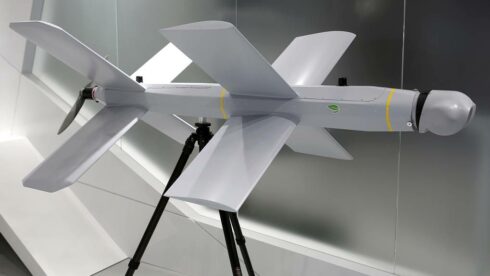
MOSCOW REGION, RUSSIA – JUNE 25, 2019: A ZALA Lancet-3 attack drone developed by Kalashnikov Concern on display at the Army 2019 International Military Technical Forum at Patriot Park. Marina Lystseva/TASS
The Russian military has destroyed one of Ukraine’s MV-10 heavy remote-controlled mine-clearing vehicles in the Kharkiv direction.
The robotic vehicle was struck by a Lancet loitering munition right after it was deployed close to the settlement of Izyum. A video showing the strike was posted to social networks on May 28, although the vehicle was falsely identified in the footage as an American-made M1150 Assault Breacher Vehicle.
The MV-10, developed by the Croatian firm DOK-ING to neutralize all types of anti-personnel mines, anti-tank mines, and unexploded ordnance. The vehicle, which weighs just over 20 tons, measures 4.6 meters in length, 2.2 meters in width, and 2.1 meters in height. It is powered by a Caterpillar C18 engine with 766 horsepower.
The vehicle can be controlled by the operator from a distance of up to 3 kilometers, with a video control system for operations beyond 800 meters.
It is equipped with a dual working assembly consisting of a chain mechanism and a knife, enabling it to withstand the detonation of anti-tank mines and effectively clear up to 3,000 m² of surface per hour. It can penetrate the soil up to 60 cm, depending on the soil type, while being protected by HARDOX 400 steel plates resistant to explosions and gunfire.
Kiev forces operate some 17 MV-10s, all donated by the European Union. Most of these vehicles are active in the directions of Mykolaiv, Kherson, and Kharkiv.
Last year, it was reported that A3Tech-Ukraine would begin producing the mine-clearing vehicle under an agreement with DOK-ING.
This was the first documented Ukraina loss of a vehicle of this type. Despite receiving much support, Kiev forces are suffering from a shortage in engineering vehicles.
Lancet loitering munitions were responsible for the destruction or damage of some 60 Ukrainian engineering vehicles, according to lostarmour.info, a website that documents military losses based on visual evidence.
The Lancet was developed by the ZALA Aero Group, a subsidiary of Russia’s defense giant Kalashnikov Concern. The company produces two versions of the loitering munition, the Izdeliye-52 with an endurance of 30 minutes and a one-kilogram warhead and the larger Izdeliye-51 that has an endurance of 40 minutes and is armed with a warhead weighting three kilograms.
The loitering munition flies towards the designated area with a GLONASS-aided inertial navigation system. After arriving in the area, the operator utilizes an onboard electro-optical system via a two-way data-link to detect, track and lock on the target. A laser-ranging system then controls the detonation of the warhead.
Ukrainian attempts to stop Lancet loitering munitions with air defense fire, electronic warfare or countermeasures have so far been mostly unsuccessful.
_______________________________________________________________________________________________________________________
SouthFront: Analysis and Intelligence
NOW hosted at southfront.press
Previously, SouthFront: Analysis and Intelligence was at southfront.org.
The .org domain name had been blocked by the US (NATO) (https://southfront.press/southfront-org-blocked-by-u-s-controlled-global-internet-supervisor/) globally, outlawed and without any explanation
Back before that, from 2013 to 2015, SouthFront: Analysis and Intelligence was at southfront.com






after encountering russia, ukraine is now lacking in every military category for some reason. still ukraine has achieved the humiliation of russia according to propagandists. but a reminder for those that left school at a young age : you do not win war by making your opponent look bad.
well, but you can start them, as with “nine eleven”.
the only thing starting is anus-penetration of russia
we are quite angry, aren’t we ? i wonder why ? badly losing, maybe ?
yes, they are really upset ;-) morpheus should use a samurai sword and a automat gun to calm them down ;-)
but you ruzzians have t-34/76 tanks as last hope. 🤣
i enjoy the complete lack of arguments of the propagandists. it is a sign of they knowing they have nothing left but insults. the sweet sweet smell of desperation.
russia produces more tanks than it loses .
russia will now regularly be “penetrated” by usa/nato missiles.
you ruzzians have lost so far 800,000 soldiers and soon using t-34/76 tanks. 😭😂
the more soldier we lose the more we win
the more bullshit you spout, the more you achieve absolutely nothing. and that is what you side is all about.
the ukraine played stupid games and is now reaping stupid prizes.
desperate russian propaganda😂
that is a lot of one liners to say absolutely nothing.
you don’t have to wonder why whole world is laughing at obsolete t-54 tanks using ruzzian military. 😉😂
leaving their make believe world will be hard for the propagandists. they think that the ‘whole world’ is them and their friends on tik tok and that a bunch of one liners are some kind of master argument. that is the problem with being an imbecile.
it will decades to clear mines and shells from ukraine . yet trump keeps the funding stream running to place more . i am sure the ukraine army keeps mine deployment records in well funded trash cans .
800k dead russians and for what
keep eating the chinese junk food and drink your bs votka
duner wott
russian military weakness has shocked russians.